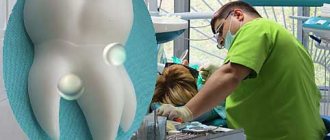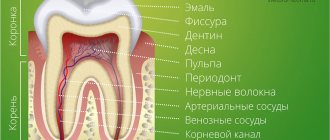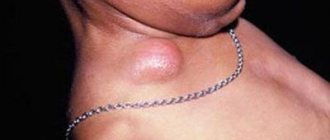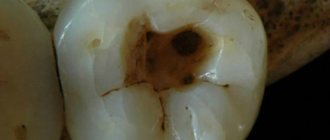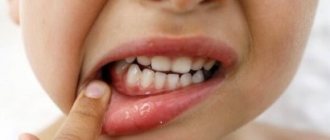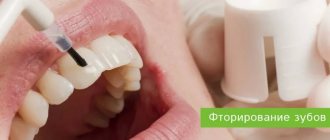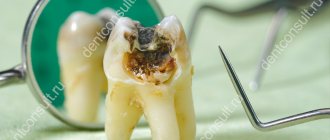Unfortunately, dental problems do not spare even the smallest children: children are often diagnosed with thinning enamel - the upper surface of the crowns is damaged, crumbled and destroyed. Enamel hypoplasia can develop against the background of disruption of metabolic processes in tissues after a viral or infectious disease in a baby or a pregnant mother.
What to do if you notice that children’s teeth have become more vulnerable and the child’s enamel has begun to deteriorate? The main thing is not to worry and start caring for your baby’s radiant smile together with the dentist.
Causes of the problem
Enamel is the hardest tissue in the body, which is continuously exposed to mechanical, thermal and chemical stress. There are many reasons for its destruction and they can all be divided into two groups: carious and non-carious.
Carious causes
Most often, it is caries that destroys teeth, and in children this happens very quickly - in a few months, snow-white milk teeth can turn into black “stumps”. Bottle caries is a problem in the first years of life, when the use of a bottle with formula or sweet liquids at night creates a favorable atmosphere for an increase in the number of bacteria, leading to the development of caries and destruction of tooth enamel.
Non-carious causes
Often teeth are destroyed due to a lack of minerals in the enamel: calcium, potassium, phosphorus, magnesium, which enter the body with food.
The main non-carious reasons why baby teeth crumble:
Enamel hypoplasia is a serious problem in which the enamel layer on a tooth may be completely or partially absent due to abnormal processes that are formed during the formation of the rudiments of teeth. The reason is a difficult pregnancy, stress, bad habits and a lack of vitamins in the body of the expectant mother.
Visually, enamel hypoplasia looks like grooves on the enamel, through which dentin shines through. Such teeth are not protected and are more susceptible to physical and chemical stress.
Fluorosis is a disease that develops due to excess fluoride in the body. The child's teeth are covered with bright white spots. This problem is caused by drinking water with high levels of fluoride content.
Non-carious lesions also include:
- poor nutrition (lack of important substances);
- lack of fat-soluble vitamins;
- high levels of phytic acid;
- excessive sugar consumption;
- excess fluoride in the body;
- enamel defects or absence;
- heredity;
- taking antibiotics during the mother's pregnancy;
- poor oral hygiene;
- the habit of chewing on everything - pencils, pens, toys, nuts, candies;
- problems of intrauterine development;
- low quality of drinking water;
- jaw injuries resulting from a fall.
Features of filling children's temporary teeth
Milk teeth are not much different in structure from molars. They have a crown, a root with pulp, nerves and vessels, and a neck. The roots of the primary dentition are reabsorbed by the time the bite changes, making way for the root row to erupt. For this reason, filling the roots of baby teeth has its own characteristics. The main rule is to make a filling from an absorbable material. This is necessary so that it does not interfere with the eruption of the molar. The most commonly used material is zinc oxide eugenol cement. Gutta-percha is used in treatment only in cases of absence of a permanent tooth germ.
Also, when filling the canals of baby teeth, anesthetics cannot be used, since it is necessary to monitor the achievement of the apical foramen. The filling material is isolated with a glass ionomer substance and subsequent restoration work is carried out. In order for the treatment of childhood caries to be as painless as possible, the procedure must be performed by experienced specialists, such as the doctors of our Aesculapius business class clinic. We are well versed in the peculiarities of the structure of the children's oral cavity and can cope with cases of any complexity. At the same time, our dental center provides excellent service conditions for both children and teenagers.
How to prevent tooth decay
What to do to prevent chipping/decay of teeth:
- ensure high-quality oral hygiene;
- limit the amount of sweets in the children's diet;
- teach your child to brush their teeth and rinse their mouth after eating;
- take your child for preventive examinations to the dentist.
Expectant mothers need to eat well, take vitamins, and treat all their teeth that need it - after all, a child’s teeth are formed in the early stages of pregnancy. Vitamins that a child should receive from food:
- Group A – butter, yolk, offal, fish, fish oil;
- Group D – pork, salmon, yolk, beef liver, fish oil;
- Group E – meat by-products, nuts, seeds, green vegetables;
- Group K – liver, yolk, butter, nuts, seeds, broccoli.
As for babies, it is necessary, if possible, to eliminate night feedings and teach them to drink water at night. You can also use xylitol - containing wipes for treating teeth, if such feedings are still present.
Why is it better to go to the Aesculapius clinic?
Cooperating with our dentistry is profitable and comfortable. We work with each client on an individual basis and always adapt to the customer's needs. Filling of baby teeth in children in our clinic is performed using the most modern equipment and tools. By contacting us, you get a number of advantages:
- high quality standards;
- responsible approach to work;
- treatment by experienced specialists;
- no queues;
- favorable prices.
You should only trust trusted professionals to fill the root canals of your child’s primary teeth. Only such specialists work in our clinic. During its existence, Esculapius dentistry has already helped hundreds of clients. Filling baby teeth for children in our clinic is safe and reliable. Absolutely all customers are satisfied. Our medical center also installs braces for children and adolescents. Experienced orthodontists have reliable and modern systems for forming a correct bite.
All you need to do to receive quality dental services is make an appointment. Getting to our clinic is very easy. We are located next to the Kyiv metro station, but there are also Studencheskaya and Kutuzovskaya nearby.
Professional treatments
To stop tooth decay, experts recommend strengthening the enamel with the help of remineralizing agents:
- fluoridation – periodic coating with solutions containing fluorine and other useful microelements;
- artificial saturation of the enamel surface with calcium and other minerals - the dentinal tubules are sealed and the density of the enamel increases;
- ozonation – destruction of bacteria in the affected tooth tissues without injuring soft tissues, helps stop destruction and cure caries at the initial stage;
- filling of dental defects;
- prosthetics – a decaying tooth is covered with a crown to isolate it from aggressive environments and stop crumbling.
- fissure sealing – sealing the chewing surface of molars with a special filling material;
The dentist chooses the appropriate treatment method, depending on the condition of the teeth and the age of the patient.
If your teeth have already begun to decay/crumple or the first signs of caries have appeared (stains on the enamel, changes in its color), do not delay your visit to the dentist. This is when time matters!
What is tooth enamel hypoplasia
The concept of dental enamel hypoplasia refers to a specific disease. It assumes that metabolic processes within the body are disrupted, which leads to improper formation and development of enamel. Due to disturbances in metabolic processes, the body lacks microelements that are necessary for enamel and its proper formation. The result is thin and fragile enamel. And if a load is placed on the tooth, it can quickly break.
Hypoplasia also indicates that protein metabolism and metabolic processes are disrupted. Hypoplasia can act as an independent disease or be a sign of another disease.
Forms of the disease
It is worth highlighting several forms:
- The color of the enamel of those teeth that were affected changes. This form is considered the easiest, because here the size of the spots is the same, and their boundaries are clearly defined. A child or an adult does not feel any discomfort, there is no pain, and there is no reaction of the teeth to irritants of a thermal or mechanical nature. Also, such stains will not take on the color of the dye;
- the enamel has not fully developed. This form of hypoplasia is already more severe. Grooves, waves, and dots appear here. If you look closely at the surface of the teeth, you can see depressions and grooves of small or medium size. The enamel in them is smooth and dense;
- enamel is completely absent. This form of the disease is also called aplasia, but it is much less common. In some part of the tooth crown there is no enamel at all. A person experiences pain and has difficulty reacting to stimuli of thermal, chemical, and mechanical types.
Restoring crumbling teeth
Simultaneously with eliminating the root cause of the pathological process, it is necessary to take measures to strengthen crumbling teeth and restore those that have already developed defects.
- Remineralization. Treatment of teeth with a special composition based on calcium and fluoride. Effective in the early stages.
- Veneers. Thin plates that cover the front surface of the tooth. Restores appearance and prevents further damage.
- Fillings. Allows you to restore the anatomical shape and function of a tooth in case of partial destruction.
- Crowns. They are used in the most difficult cases, when most of the tooth is damaged [2].
The main rule that must be followed when teeth are crumbling is: do not self-treat. This behavior will definitely make the situation worse. Having noticed the first signs of a problem, make an appointment with the dentist as soon as possible and undergo a comprehensive examination.
List of sources
- Konovalova E. A., chief physician of the Dental Standard clinic, video blog “Why do teeth crumble? How to deal with this? // URL: https://zubnoystandart.ru/novosti/videoblog-stomatologa-pochemu-kroshatsya-zuby/ (accessed March 16, 2021).
- Pismanik V.S., chief physician of the Doctor Dent clinic, article “Why do teeth crumble?” // URL: https://www.clinikadoctordent.ru/about/articles/pochemu-kroshatsya-zuby/ (accessed March 16, 2021).
- Ogonyan V. R. Hereditary non-carious lesions of hard dental tissues. Volgograd: Federal State Budgetary Educational Institution of Higher Education "VolgSMU" of the Ministry of Health of the Russian Federation, 2022. // URL: https://rep.barsu.by/handle/data/2823 (access date 03/16/2021).
In what cases is it necessary to remove a baby tooth?
Unfortunately, there are times when baby teeth cannot be saved, and then the dentist must prescribe an extraction procedure.
Reasons for removing a baby tooth:
- advanced caries, which led to irreversible destruction of the crown;
- pulpitis, gingivitis, periodontitis, fistula, cyst in advanced forms;
- increased tooth mobility.
How to treat
Dental hypoplasia today is considered a process that cannot be cured or reversed. There are no medications that can relieve symptoms. As for the treatment of dental hypoplasia, it is usually symptomatic. It is also possible to reconstruct the tooth enamel.
If the lesions are small, then you can do nothing, since the child or teenager’s teeth will not hurt. If there is erosion on the enamel, or there are deep stains, then the tooth needs to be filled using composite materials.
If there is no enamel on the surface of the teeth, the doctor may prescribe orthopedic treatment or prosthetics. But it is very important to remember that if such a disease or symptoms are identified, it is important to initially consult a specialist. You cannot self-medicate, otherwise serious consequences may occur.
How to strengthen enamel at home?
To protect the enamel from damage, it is recommended to follow a balanced diet (the diet should contain foods containing calcium - fermented milk products, almonds, hazelnuts, beans, peas, meat, hard cheeses, oatmeal and barley), and take vitamins with calcium.
Special toothpastes (for example, Vivax Dent, Elmex, ApaCare, Lacalut) and gels (ROCS, Amazing White Minerals) are also indicated.
Do not forget that the result of treatment depends on the professionalism of the dentist. On our website you can find a list of clinics that successfully treat this disease.


